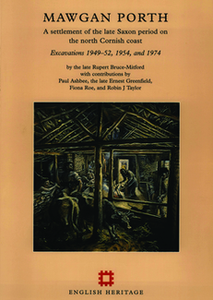English Heritage Archaeological Monographs
English Heritage, 2014. https://doi.org/10.5284/1028203. How to cite using this DOI
Data copyright © English Heritage unless otherwise stated
This work is licensed under the ADS Terms of Use and Access.
Primary contact
Historic England
The Engine House
Firefly Avenue
Swindon
SN2 2EH
Resource identifiers
- ADS Collection: 1416
- DOI:https://doi.org/10.5284/1028203
- How to cite using this DOI
Mawgan Porth: A settlement of the late Saxon period on the north Cornish coast: Excavations 1949-52, 1954 and 1974
Bruce-Mitford, R.
English Heritage (1997)
Abstract:

Mawgan Porth lies c 55m from the sea on the northern slope of the Vale of Lanherne near the North Cornish coast and faces south on to the floodplain of the River Menalhyl. Excavations in 1950-52, 1954 and 1974 uncovered three distinct, but similar, groups of buildings known as courtyard houses and a cemetery, all containing evidence of a date of occupation between c AD 850 and 1050. Each courtyard group comprised a long main room along one side, with a partitioned end for livestock, several smaller rooms or walls around the remaining sides, and a narrow entrance. The living area of the main room included a hearth and various vertical slab features and wall cupboards. Traces of earlier buildings and occupational materials were found beneath the courtyard houses. The cemetery contained adult and child burials enclosed in slab graves. Pottery from the excavations forms a homogenous group with distinctive forms and fabric, partly inspired by the bar-lug tradition of Scilly and Cornwall with possible derivations from similar devices on contemporary Continental pottery. Other finds included simple stone tools made from local and regional materials, an abundance of perforated local slates, a few bone artefacts, iron traces, and a silver penny of Aethelred the Unready, struck between AD 990 and 995 (from a small room in Courtyard House 1). Associated animal bones indicate a domestic economy, supplemented by shell fishing. Abandonment, and possibly resettlement inland at St Mawgan, appears to have been caused by difficult sandy and windy seashore conditions.
Download monograph
| Mawgan Porth: A settlement of the late Saxon period on the north Cornish coast: Excavations 1949-52, 1954 and 1974, Bruce-Mitford, R., English Heritage (1997), ISBN: 9781848021860 | 24 Mb |





